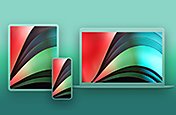Digital Printing: Methods and Benefits
Since its emergence in the early 90s, digital printing has revolutionised the print industry. Long gone are the days of long turnarounds and complex set-up - printing options have become nearly unlimited with the rise of digital methods.
Looking to discover more about the wonders of digital print? You’re in the right place. From learning about different digital printing methods to understanding the benefits of digital print applications and printing services in the real world, let’s explore what’s involved.

What is digital printing?
Put simply, digital printing is the process of transferring a digital-based image directly onto the surface of a material - often using a digital printer. This material can be anything, from a piece of paper to your favourite coffee mug. If you happen to have a customised t-shirt in your wardrobe with your favourite quote printed on it, it was most likely done with digital print equipment.
Digital printing has become increasingly popular as computers have become more affordable and accessible. Through a computer, someone with access to graphic design software like Adobe Photoshop can use digital printing technology to print out their creations, customise items or even start a print business.
Digital vs offset printing.
The digital printing process differs greatly from the traditional or analogue printing methods that have been in use for several years, particularly offset printing.
Offset printing method
Before you start thinking about logos and tones of voice, you’ll need to carefully consider your brand and its audience.
- In offset printing, the printing press transfers ink from a metal plate to a rubber roller.
- The roller then transfers the ink onto a medium surface to produce high-quality designs and images.
- Offset printing is typically used in mass production industries for printing on items such as stationary, boxes, magazines and newspapers.
Digital printing method
- A digital printing press doesn’t require metal printing plates to transfer an image onto a surface. Instead, a digital printing machine applies inks in a thin layer on the surface of the medium.
- Adherents are then added via heating or curing techniques to make the image more permanent.
- Because the image is printed directly onto the material, digital printing is a high-speed and cost-effective method, especially for smaller (customised) projects.

Different digital printing methods
There are different types of digital printing methods available depending on the type of industry and needs of the consumer.
- Solid ink. Used mainly for large-scale printing operations by graphic designers. With solid ink, solid ink sticks or blocks are used to create long-lasting images. These blocks are melted inside the printer before being applied to the chosen surface via heated rollers. As the ink cools, it solidifies into a fully formed imaged.
- Inkjet. One of the most popular forms of digital printing at home that allows people to print on-demand. Printers apply ink as tiny droplets, spraying them onto a chosen surface in precise patterns to create an image.
- Laser. Another widely used digital printing method, particularly in offices due to its fast turnaround. A laser beam is used to make specific parts of a special drum or belt electrically charged. These charged parts attract tiny toner particles. The toner particles stick to the charged areas. Then, heat is used to fuse the toner particles onto the printing material, creating the final image.
- Dye. Also known as ‘dye sublimation’ and popular for producing high-quality photographic prints, apparel, signage and promotional items. Here, dye is printed onto a transfer paper or film, which is then pressed onto the intended surface using heat and pressure, causing the dye to sublimate and permanently bond with the surface.
What you’ll need to print digitally
Looking to venture into digital printing? Here’s what you need to know to get started.
Digital printing technologies
Getting started with digital printing may require some investment in digital print technologies. Fortunately, these technologies can be quite affordable and easily accessible.
The first step in print production may involve finding a good device, such as a laptop or tablet, together with a mouse or stylus. These will be the canvas and paint brush for any digital-based images or digital art you’re looking to create.
You can then start creating your first set of images to print by downloading and installing image editing or illustration software like Adobe Photoshop. Adobe’s easy-to-use workspace and multiple features helps you craft high-quality images with ease.

Digital printing equipment
Depending on the type of digital printing method you’re looking to get into, you might find yourself investing in different types of printers, inks, toners and other equipment.
For example, a dye sublimation printer might be worth investing in if you’re looking to create large volumes of merchandise such as t-shirts and banners. On the other hand, if you’re looking to print lengthy documents for clients, then you’ll be more focused on purchasing an inkjet or laser printer.
Benefits of digital printing
Now that you have the basics of digital printing, let’s look at some of the benefits this modern form of printing offers:
- Faster printing speeds. With digital printing, there are fewer steps involved in setting up and executing a printing project. This means that you can get high-quality prints with shorter turnaround times.
- Easier to edit digital images. Edits can easily be made to the original digital file. You can even program some images to be updated automatically based on data inputs made through software programs such as Adobe Photoshop.
- Cheaper maintenance costs. Digital printing devices don’t come with the additional machinery of offset printing devices, such as metal plates, making them cheaper and easier to maintain.
- Volume order can be customised. Unlike offset printing - which is mainly targeted for mass production prints - digital printing can be modified to print quicker and cheaper for small projects, like business cards and stickers, making it more cost-effective.
- Regular updates to improve the product. Since digital print is a technological solution, it benefits from regular updates designed to improve image quality and general digital print technologies and processes.
Digital print FAQs
What can you do with digital printing?
There are different digital printing technologies tailored for different printing purposes. For example, solid ink is used for large-scale print operations by designers, while inkjet and laser printers are more commonly found at homes and offices for paper printing needs.
What is an example of digital printing?
When you print a PDF file on your computer onto an A4 paper, that’s a simple example of digital printing - or when you get a customised print of your favourite quote onto a plain white t-shirt.
What do you need for digital printing?
To get started with digital printing, you’ll need a device, such as a laptop or tablet (accompanied by a mouse or stylus), to start creating and editing digital images using software like Adobe Photoshop. Once you’ve created your digital-based image, you’ll require a digital printing device depending on what end purpose you have with your print.
Create designs to print with Adobe Photoshop
An exciting adventure awaits you in the world of digital print. So, what are you waiting for? Get started on your first breathtaking digital art with Photoshop.
You might also be interested in…
Set a mood with secondary colours.
In this secondary colours beginner's guide, discover how different colour combinations can help you to make a splash with attention-grabbing work.
Add complex watercolour textures to your digital paintings.
Learn how background textures can bring depth to digital watercolour paintings.
Create professional-quality backgrounds for any kind of media.
Discover how to craft professional-quality backgrounds for presentations, desktops and other projects.


